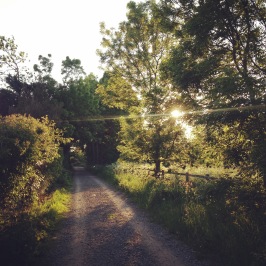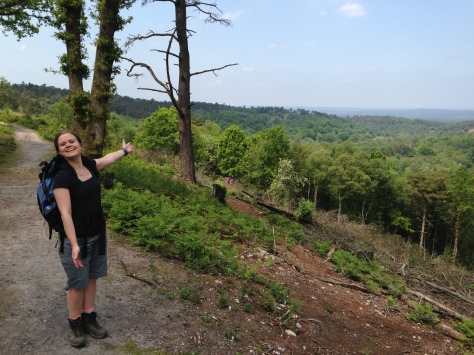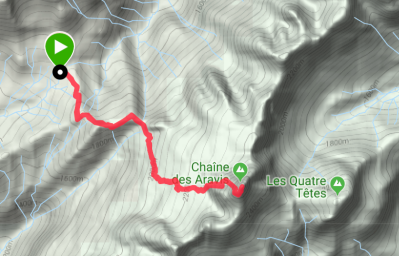
It pains me to write, dear reader, that I haven’t been doing too well lately. In an intense pattern that repeats itself over a cycle of roughly 28 days (make of that what you will), I have been rollercoastering along a path that consists of high-highs and desperately low-lows. The latter have been exacerbated by a relatively isolated Summer, during which the bulk of my time has been spent writing at home or at the University Library, and endlessly drafting and redrafting my CV and research proposal for job applications. Being on the academic job market takes resilience. I was recently interviewed for a position for which I spent two weeks researching and writing on the required topic of the teaching presentation – the only job to have been advertised in my field in the UK in the last year. When I found out I didn’t get it, still high from the interview buzz, I cried solidly for an hour and got straight into bed, still wearing my best interview dress.
As treatment for the low-lows, I have found three relatively dependable remedies: food, friends, and walking. Whilst I’ve (ahem) been (over?)indulging in the first of these, the second and third are hard for me to come by in Cambridge, and often have to be sought out further afield.

The last day of our four day trip to Villaz was to be our big mountain day. Originally, two of these were included in the plan George and Lise had prepared for us to all do together, but the climb up the Tournette was cancelled due to hiking-inclement weather at the summits. That left us with time for just one quality mountain day: the Pointe Percée. Pete and I had been looking forward to climbing this since George sent us a picture of the view from the top almost exactly a year ago to the day. The pressure was on: this hike had to count.
Not even half an hour into a three-hour ascent, the mean blues hit. On the way up the first part of the approach, I lagged towards the back of the group, taking photos of the surrounding valley. My mind wondered onto two applications I need to complete this week. I felt a familiar dark fog seeping into my mind – a big black cloud that starts with a negative thought, and expands like a tumor, first filling my head with darkness, working its way down until it gradually paralyzes my body. I stopped. I couldn’t walk on. A whole mountain still left to climb, and I was frozen to the ground.
Pete ran back towards me, and gently offered me a series of choices. Did I want to go back to the car? No. Did I feel strong enough continue? I didn’t know. Would I keep walking until the refuge? Yes.
We carried on together, one step at a time, Pete two steps behind. It felt good knowing he was right there.
An hour and a half in, we had reached the refuge de Gramusset at 2,160 metres. I was still quiet, still shaken, but my mood had lifted – I guess the adrenaline had started to do its work. At this point, it didn’t occur to me not to carry on.
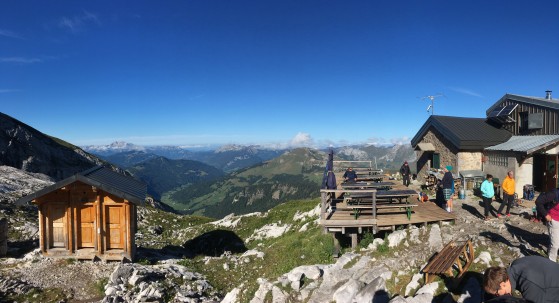
The next part of the path became busier and busier. There were three tents near the refuge, and it looked like quite a few hikers had stayed in the refuge overnight to be in a better position for the ascent the next morning. The Pointe Percée is a well-known hike in itself, but it also forms the pinnacle of the magnificent Aravis range, so we were in the company of several climbers who were kitted out with ropes and helmets, as well as couples hiking with mountain guides, and amateurish hikers walking in jeans and trainers.
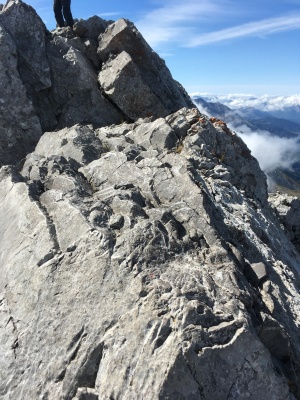
From the refuge onwards, the ascent is roughly 50% walking, 50% climbing and scrambling. The trail is easy to follow as it is marked out with red dots painted onto the rocks every ten metres or so, but the route is just as easily felt as it is seen: you can immediately tell when you’ve made a false move because the rock is rough, not having been softened by the hands of countless climbers!
After an ascent over a rather arduous scree slope, the crowds began to bottleneck and we came to a stop. A young red-haired girl was tackling a particularly difficult move over a smooth and slippery boulder. Her boyfriend had already made it over, and was looking on, slightly worried. An older man (possibly the boyfriend’s father) was helping the girl up. Suddenly, she pulled away.
‘No, I can’t do it. I can’t go on,’ she whispered, turning her back to the mountain and taking a step back, putting both hands to her eyes. The older man put his arm around her while her boyfriend watched helplessly. We waited a moment, then George and Lise slipped on past. As I waited my turn to clamber over the mighty boulder, I heard the man tell the girl: ‘It doesn’t matter that you can’t do it, just look around you. What do you think of the scenery? Isn’t it extraordinary?’. He was right, it was. I desperately wanted to go over and reassure her – she wasn’t the only one to break down part way up a mountain! I had been in her position before, but it would have been so much worse to be surrounded by an audience!
The move on which the girl had got stuck was not easy – a big step up from a steep slope onto a slippery foothold that was just out of view, and a big pull through a narrow gap. It took me a bit longer than the first two, but I made it through, and spider-Pete followed – as usual, without the slightest difficulty.
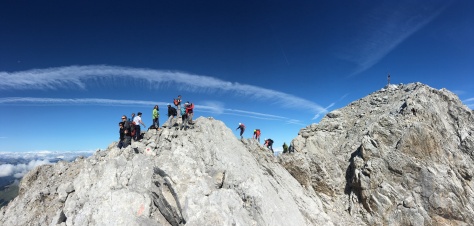
Despite occasional difficult moves like this one, I really enjoy this kind of scrambling. Unlike walking over rough ground, the pace slows right down, the mind has to focus. It’s still tiring, but each step is measured and carefully thought out. It’s concentrated: the only thing it’s possible to think about is the climb itself. The steps up, across, and over chained on from one another like the momentum of inhaled and exhaled breaths, and next thing I knew, we had made it onto the ridge itself. All that remained was to join the queue to reach the summit. A spectacular view towards Mont Blanc had opened up ahead of us, but at this point, it’s dangerous to take your eyes off the trail.
Another 60 vertical and 150 horizontal metres to go, and we had made it. So had the red-haired girl who had been struggling further down the mountain! I was so thrilled for her, I had to keep myself from going over to congratulate and hug her! I wanted to tell her how difficult I had found my first scramble, and how I had broken down the first time I finished my first proper outdoor climb. That would have been patronising; I kept my thoughts to myself.
On our way back down the Pointe, the clouds started to roll in, but the ones in my head had well and truly dissipated. Back at the refuge, we picnicked on baguette sandwiches. Over coffee afterwards, we did a four-way fist bump to mark the end of the arduous part of the hike. It was one helluva mountain, but we did it!
Food, friends, and walking – I’m telling you, they work!







